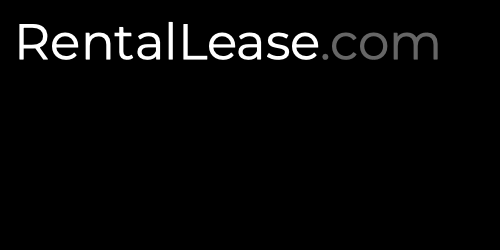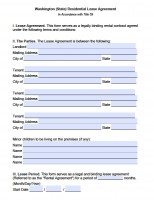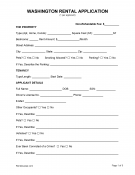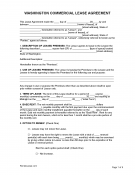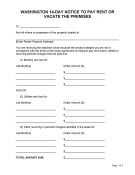The Washington (state) rental agreements are contracts and forms designed to aid in the process of renting residential or commercial property to a tenant. All documents have been created in accordance with State law (Commercial 62A.2A | Residential Title 59) and must be completed in the same manner. The lease agreements found on this page are between a landlord and a tenant; in most cases, the tenant is an individual, but the renter may be a business or other entity if they are signing a commercial lease agreement. The terms and conditions contained within these agreements should be negotiated between the two parties. This list of forms also includes a rental application form (for vetting prospective tenants) and a notice to quit form (used to warn a tenant that they are currently in default of their agreement).
Washington Rental Lease Agreement Templates | PDF
Washington Lease Agreements
The Washington standard residential lease agreement is used to establish a rental arrangement between a landlord and a tenant. Before accepting an individual as a tenant, the landlord will most likely have interested parties complete a rental application form. Once they have chosen an eligible individual, the new tenant and landlord will look over the written residential lease agreement. The terms and conditions should be fair for both parties before the document is signed. Once the agreement is signed, it…
The Washington rental application is a screening document used by landlords to verify an individual’s income, employment status, rental history, and other background information. The landlord has the option of digging deeper into the potential tenant’s background by viewing any liabilities, bank account balances, and requesting references such as previous property owners or managers that have had experience with the individual. Gathering this information will help the landlord make a decision regarding the applicant’s eligibility for tenancy. The landlord is allowed…
Washington month-to-month lease agreement is a similar document as the standard lease agreement except that this type of lease operates within a temporary, yet indefinite, system. Whereas the standard lease usually ends after one (1) year’s time, a month-to-month agreement carries on exactly as the title suggests; on a month-to-month basis. This allows the tenant to pay rent every month without having to commit to a long-term lease. The landlord will continue to receive rent from the tenant until one…
A Washington commercial lease agreement lets a property owner of retail, office, or industrial type space rent to a business (tenant) operating as an individual or entity. (If the business is an entity, the landlord will want to verify it’s existence with the Secretary of State’s office.) The lease agreement document will be presented to the person representing the business by the landlord and the terms and conditions contained therein will be negotiated between the two parties. Details such as…
The Washington fourteen (14) day notice to quit is a form served upon a tenant who has failed to pay rent in a timely manner. Rent is due as per the lease agreement and once the due date has passed, the landlord may deliver the notice to quit notifying the tenant of their default. The tenant has fourteen (14) days to remedy the situation, either by vacating the premises or paying the amount due. Failure to do either of those things…
The Washington sublease agreement is used to sublet rented space, either a portion or the entirety of, from a tenant to another person. The tenant will be acting as the sublessor and should always check with the landlord to make sure they approve of the situation. The sublessor should understand that in a sublet situation they will always be responsible for the new tenant, or sublessee. Therefore, the tenant should always screen any individuals with the rental application form to check…
STATE DISCLOSURES
Checklist (59.18.260) – If the landlord requires a security deposit from the tenant, this form must be completed and signed after reviewing the current condition of the premises.
Fire Safety (59.18.060(12)) – The landlord must inform the tenant of the types of alarms and safety guides inside the rental unit prior to move-in.
Mold (§ 59.18.060(13)) – Landlords must furnish tenants with information (approved by the department of health) regarding health hazards associated with mold exposure and how to control/prevent mold. This can be delivered directly to tenants or posted in a public area at the property. (Suggested material – A Brief Guide to Mold, Moisture, and Your Home.)
Nonrefundable Fees (59.18.285) – Any fees that are not refundable must be clearly detailed in the written lease agreement.
Security Deposit (§ 59.18.270)- The tenant must be made aware of the bank name, institution, and address of the branch into which their security deposit was transferred.
Name and Address (§ 59.18-060(15)) – Tenant must receive the name and address of the person in charge of the property (landlord or manager).
Lead-Based Paint – Landlords looking to rent a house/apartment constructed prior to 1978 must provide the prospective tenant with this Federally-mandated disclosure form.
SECURITY DEPOSITS
Maximum – There is no limit to the amount a landlord may charge for a security deposit at the beginning of the lease.
Returning (§ 59.18-280) – The landlord must give back the deposit, and all funds associated with it, to the tenant within twenty-one (21) days after they move out.
LANDLORD'S ACCESS/ENTRY
Except for emergency situations, the landlord must provide at least two (2) days' notice before entering a tenant's property (§ 59.18.150).
